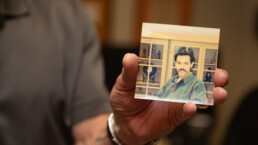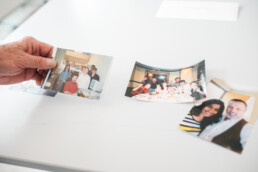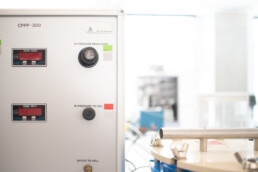Longtime CPE building manager Glen Baum retires after 30+ years, numerous university awards and one unprecedented pandemic
by Stacia Miller
An intricate carving of the Hindu elephant god Ganesha. An etching of Chinese shadow-puppet horses. An old Bank of England £5 note, a Nigerian teapot and a postcard from Turkey.
For more than three decades, Glen Baum has traveled the world every day just by stepping into his campus office in the maze of corridors that is the university’s Chemical and Petroleum Engineering Building (CPE). The longtime Hildebrand Department of Petroleum and Geosystems Engineering (PGE) lab coordinator and CPE building manager has shelves of souvenirs from students who have passed through the labs he has managed since coming to The University of Texas at Austin. Many of those students hail from countries thousands of miles away, both geographically and culturally, and Baum’s soft Texan twang, industriousness and endless supply of patience are welcome salves.
“My favorite part of the job is still the students,” he says. “It’s amazing to see their faces light up simply because I’ve offered a smile and a helping hand. I’ve been so fortunate to make lasting friendships and learn about so many different cultures.”
While Baum’s hospitality has remained a constant, he has been front and center for the Cockrell School’s evolution into one of the world’s best engineering institutions. From conducting equipment inventories using mimeographed lists to working solo in the 225,000-square-foot CPE building during the COVID-19 pandemic, he has seen (and done) just about everything. Now, with his retirement planned for June, he reflects on his time in Texas Engineering — what’s changed, what hasn’t and why he’s thankful for burnt orange.

Glen Baum’s first-ever staff photo at UT Austin, taken in 1990.
Welcome to the Bungle
Baum joined the PGE department in 1990 as lab manager for now-retired professor Martin Chenevert, after spending five years calibrating test instruments for the U.S. Air Force and nine years supervising oilfield electrical installation for Oryx Energy. Almost immediately, Baum gained a reputation among Chenevert and his graduate students as a collaborator and a creative thinker.
If you needed something built or adapted for a particular project, Glen could always come up with a solution,
remembers Varadarajan Dwarakanath (M.S.P.E. 1992, Ph.D. P.E. 1997), who moved to Austin from India in 1990 to work on his master’s degree with Chenevert. As the end user of many of Glen’s set-ups, I knew him to be smart, safe and organized.
But even more than that, he was one of the nicest people I’d ever met. He made me feel at home in this strange new place,
said Dwarakanath. No matter what you looked like or where you came from, he welcomed you.
Just 11 months into the job, Baum became CPE’s first building manager. His primary responsibility was to get the undergraduate teaching labs back in working order — and keep them there. Though the building was just 5 years old, much of the lab equipment had been poorly maintained. The lab experience for undergraduates was not consistent with the department’s excellent reputation.
Being building manager was a very reactive job at first — replace this equipment, fix this leak, repair this machine,
he remembers. And this was in the ‘dark ages’ before the campus was outfitted with internet and Wi-Fi.
Baum would receive a paper list of everything that was supposed to be in a particular lab. He would check off what was there and indicate what was missing, then place the marked-up inventory back in campus mail and … wait. Wait for memos to arrive from purchasing, accounting, the PGE chair, the dean’s office, faculty committees and whoever else needed to weigh in. Let’s just say, everything moved very slowly, but we eventually got it done.
It was a bit of a mess,
concurs professor Mukul Sharma, who served on the committee that hired Baum. But Glen came in, with his measured demeanor and scientist’s mind, and cataloged, replaced and organized everything. It was such a relief for those of us who were teaching — we could return our focus to our students and be assured that their experiences in the labs were the caliber that we expected.

The “magic suitcase” that Baum would pack for faculty members traveling to conferences and recruiting events to demonstrate their work.
Baum and the Magic Suitcase
In addition to managing the undergraduate teaching labs, Baum supervised the department’s technical staff; trained graduate research assistants; and continued installing, repairing and even fabricating equipment for faculty research. If you needed something for an experiment, no matter how bizarre or outlandish, you went to Glen,
says professor Maša Prodanović. And he didn’t raise his eyebrows and yell, ‘Impossible!’ He just figured it out and made it happen for you.
Cases in point: the study carrell cart that Baum outfitted so that the late professor Ben Caudle could wheel the department’s first computer, a giant IBM AT, around to classes. The rock Baum collected personally from the Grand Canyon’s South Rim for professor emeritus Gary Pope’s research. And the travel kits that Baum assembled with tubing, funnels, beakers, distilled water and specially formulated mineral oil so that Prodanović and other faculty members traveling to conferences and recruiting events could demonstrate subsurface geomechanics at a moment’s notice.
Even though I often returned it in shambles or with things missing, it was repacked and waiting for me every time I needed it next,
says Prodanović. We all called it our magic suitcase.
But the real magic, says Baum, has been the PGE faculty’s longstanding expertise. Our professors have stayed consistently top-notch over the years,
he says. Even as we’ve broadened our focus to include areas that weren’t even part of the industry 25 years ago, like geothermal energy, rare earth elements and methane emissions reduction, the level of faculty excellence is still unmatched anywhere else.

Baum piled up awards, accolades, memories and friends over his more than 30 years in the department.
Nanotechnology and Tex-Mex
That expertise drew Prachi Mehta (M.S.P.E. 2015) to PGE in 2013 to work on her master’s degree. She joined the research team of former professor Steven Bryant to work on nanotechnology innovations to improve the flow assurance of pipelines. As she began designing her research project, often spending upwards of 20 hours a week in the lab, she ran into a problem.
The heating coil I was using kept tripping and it got to a point where I couldn’t continue my work,
she remembers. I didn’t know what to do, so I asked Glen for help. He had so much knowledge and was so handy.
Like Dwarakanath, Mehta was an international student who had moved to the United States to enroll at UT Austin. My dad was far away back in India, and Glen became a father figure to me,
she says. Even after she graduated (dedicating her thesis in part to Baum) and worked in other cities like Denver, Houston and San Francisco, she kept in touch. When she visits Austin, she and Baum still meet for queso and margaritas or a walk through the garden at his home in Bastrop.
The best advice he ever gave her, during a bout of homesickness, she says, was not to wish my life away. To work for what I wanted but also to be happy where I was. And he was a living example of that — he’s so passionate and loves what he does.

No stranger to pressure, Baum stepped up to quickly pivot to remote education during the early days of the COVID-19 pandemic.
Learning on a Dime: COVID-19 and the Quiet Year
The COVID-19 pandemic put that passion to the test. As CPE building manager, Baum was considered essential personnel, so day after day he traveled empty roads to an empty campus to work in an empty building.
Walking the halls and remembering the level of activity that used be there was so eerie,
he says. I just tried to focus on doing what needed to be done to keep everything running.
For Baum and PGE IT director John Cassibry, that meant being creative and nimble as they quickly moved every class online. Baum made video demonstrations of undergraduate labs and posted them on YouTube. He packed up and mailed lab supply kits to each undergraduate student so they could conduct experiments from home. Once small groups of graduate students were allowed to resume in-person research, he coordinated movement in the building to minimize risk, making stairwells and hallways one-way. Baum also dealt with a mold bloom in the aging CPE building, which required an overhaul of the airflow system and the installation of air handlers on every floor and intake vents on the roof.
Glen’s leadership during that time was invaluable to all the staff trying to manage in difficult circumstances,
says Cassibry. His dedication and responsibility helped keep the department from falling apart, literally and figuratively.
At the same time, the Cockrell School was knee-deep in constructing the Gary L. Thomas Energy Engineering Building, the new home of many of PGE’s laboratories, classrooms and offices. As PGE’s point person for the new building, Baum juggled Zoom meetings with contractors and research teams, pandemic-related material shortages, skyrocketing prices and labor shortages.
On the plus side, he remembers, the parking situation on campus was amazing.

Baum helped usher in a new era, leading the transition of PGE labs, classrooms and offices to the new Gary L. Thomas Energy Engineering Building.
Glen Baum Has Left the Building … Sort Of
After 33 years, though, Baum is ready for something else amazing: retirement. He hopes to spend more time in his garden and travel — he has family in France, and Machu Pichu is high on his bucket list. He will also likely return to campus part time for at least a few months to train his replacement.
His advice?
“Never say no. Have plenty of patience. Know that today’s problem will always be replaced by a new one tomorrow. And remember that you’re in one of the best departments, in one of the best engineering schools, at one of the best universities in the country. Make sure your work ethic reflects that.”
Over the years, Baum’s work ethic has earned him two PGE Staff Excellence Awards, three Cockrell School of Engineering Staff Excellence Awards, and two President’s Staff Awards. Perhaps the greater honor, though, is just how far his reach extends beyond the Forty Acres.
I’m 26 years out of school and have easily hired more than 50 or so PGE students,
says Dwarakanath, now chemical recovery mechanisms team leader at Chevron. When I ask them who they remember, one name stands out — Glen Baum. He just treats people with such love.